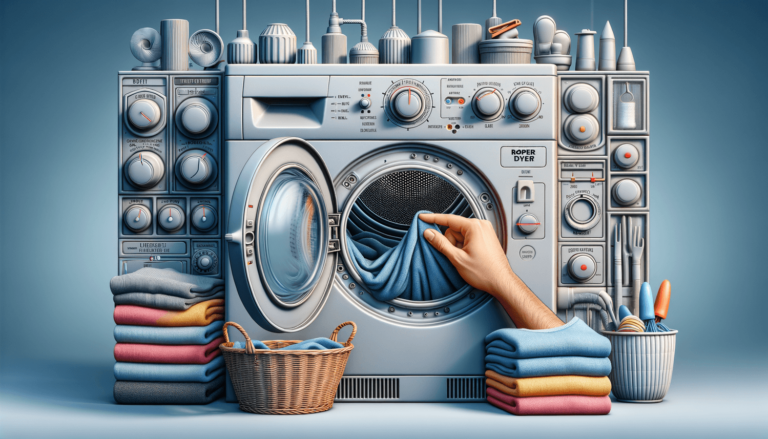

When it comes to achieving perfectly dried and well-maintained garments, the right settings are essential for your appliance’s efficiency. In this blog post, we’ll explore Roper Dryer Settings to help you understand the various options available on these reliable machines. We’ll delve into their functions and provide guidance on how to choose the most suitable settings for your laundry needs. So, let’s jump in and master the Roper Dryer Settings to guarantee the best results and
Automatic Dry Cycles make use of a moisture sensor to detect the level of moisture in your clothes and stop the dryer once they’re completely dry. This prevents over-drying and saves energy.
Timed Dry Cycles allow you to set a specific drying time for your laundry. This option is best used when you need more control over the drying process.
The Fluff Air Dry Cycle is designed to freshen up items like pillows, stuffed toys, and garments that are only slightly damp. This setting tumbles the load without heat, preventing shrinkage and heat damage.
The Wrinkle Prevent Option keeps your clothes tumbling at specified intervals after the drying cycle has completed. This helps to minimize wrinkles by keeping the clothes from sitting in one position for too long.
The End-of-Cycle Signal alerts you when your drying cycle is completed. This helps you to promptly remove clothes and minimize wrinkles.
As a Settings King, we understand the need for customization and efficiency when working with Roper Dryer Settings. Here are some helpful tips to achieve optimal results for different laundry needs using the variety of dryer settings available:
For the most effective drying of heavier loads, use the “More Dry” Automatic Dry Cycle or set a longer drying time on the High Heat Timed Dry Cycle. This will ensure your items are uniformly dried and ready for use.
When drying delicate fabrics like silk, lace, or anything prone to heat damage, opt for the Low Heat Timed Dry Cycle or the Less Dry Automatic Dry Cycle. For added care, you can also use the Fluff Air Dry Cycle for a gentle, heat-free tumble.
Enable the Wrinkle Prevent Option to keep your clothes looking polished and ready to wear. Pair this with the appropriate Automatic Dry Cycle or Timed Dry Cycle, depending on your load. Remember to unload your garments promptly after the End-of-Cycle Signal to further minimize wrinkles.
If you have clothes that just need a quick refresh or are slightly damp after air-drying, use the Fluff Air Dry Cycle. This will circulate air without heat, eliminating unwanted odors and excess moisture while avoiding damage caused by heat.
At Settings King, besides guiding you on mastering your Roper Dryer Settings, we also recommend keeping your dryer well-maintained for optimal efficiency and performance. Follow these simple tips to keep your Roper Dryer in top condition:
As a responsible technology settings blog, Settings King encourages energy efficiency to reduce your environmental footprint. Choosing the right Roper Dryer Settings optimizes energy consumption and ensures the longevity of your appliance. When possible, use Automatic Dry Cycles with their moisture-sensing technology, to minimize energy waste and avoid over-drying your garments.
Understanding your Roper Dryer Settings is crucial for obtaining the best results while optimizing energy use. With the guidance of Settings King, you can now effectively navigate through various settings, confidently tackle different fabric types, prevent wrinkles, and keep your dryer in excellent condition. Happy drying!
As a part of Settings King, we understand that our readers may have more questions about Roper Dryer Settings. To address some of the common queries, we have compiled a list of frequently asked questions and their concise answers.
If your clothes are still damp after an Automatic Dry Cycle, try a longer Timed Dry Cycle on a suitable heat setting for that particular fabric type. Make sure your lint filter and exhaust vent are clean to ensure proper airflow and dryer efficiency.
Yes, fabric softener sheets can be used during any of the dryer cycles. Simply place the sheet in the drum along with the wet clothes before starting your desired drying cycle. However, always follow your fabric softener sheet’s guidelines to prevent any residue buildup in your dryer.
For mixed loads, choose a setting that caters to the most delicate or heat-sensitive fabric in the batch. Ideally, opt for the Normal Dry Automatic Dry Cycle, or use the Medium Heat Timed Dry Cycle with a moderate drying time.
If your dryer is making unusual noises, first inspect the drum to ensure there are no loose items like coins or keys causing the noise. If the noise persists, consult the user manual for troubleshooting guidance or contact a professional technician for assistance.
Roper Dryers do not have a specific sanitizing setting. However, you can use the High Heat Timed Dry Cycle or the “Very Dry” Automatic Dry Cycle to effectively eliminate germs and bacteria, as long as your garments can withstand high temperatures.